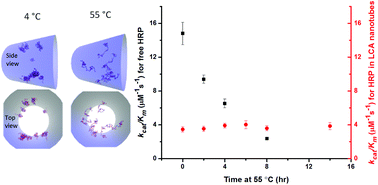Catalytic activity and thermal stability of horseradish peroxidase encapsulated in self-assembled organic nanotubes
Abstract
Horseradish peroxidase (HRP) was encapsulated in self-assembled lithocholic acid (LCA) based organic nanotubes and its catalytic activity before and after thermal treatment was measured for comparison with free HRP. The apparent kcat (kcat/Km) for nanotube encapsulated HRP remained almost the same before and after thermal treatment, reporting an average value of 3.7 ± 0.4 μM−1 s−1. The apparent kcat value for free HRP decreased from 14.8 ± 1.3 μM−1 s−1 for samples stored at 4 °C to 2.4 ± 0.1 μM−1 s−1 after thermal treatment for 8 h at 55 °C. The Michaelis–Menten constants, Km, determined for encapsulated HRP and free HRP were relatively unperturbed by storage conditions at 4 °C or thermally treated at 55 °C for varying time periods from 2–8 h, with encapsulated HRP having a slightly higher Km than free HRP (13.4 ± 0.9 μM versus 11.7 ± 0.4 μM). The amount of HRP encapsulated in LCA nanotubes increased dramatically when the mixture of HRP and LCA nanotubes was brought to an elevated temperature. Within 4 h of thermal treatment at 55 °C, the amount of HRP encapsulated by the LCA nanotubes was more than 4 times the amount of HRP encapsulated when equilibrated at 4 °C for 7 days. Molecular dynamics (MD) simulations show that the higher degree of exposure of hydrophobic residues in HRP at elevated temperatures enhances the hydrophobic interaction between HRP and the nanotube wall, resulting in the increased amount of HRP surface adsorption and, hence, the overall amount of encapsulation inside the nanotubes.


 Please wait while we load your content...
Please wait while we load your content...